Bitcoin
Why is crypto crashing right now?
Published
5 months agoon
By
admin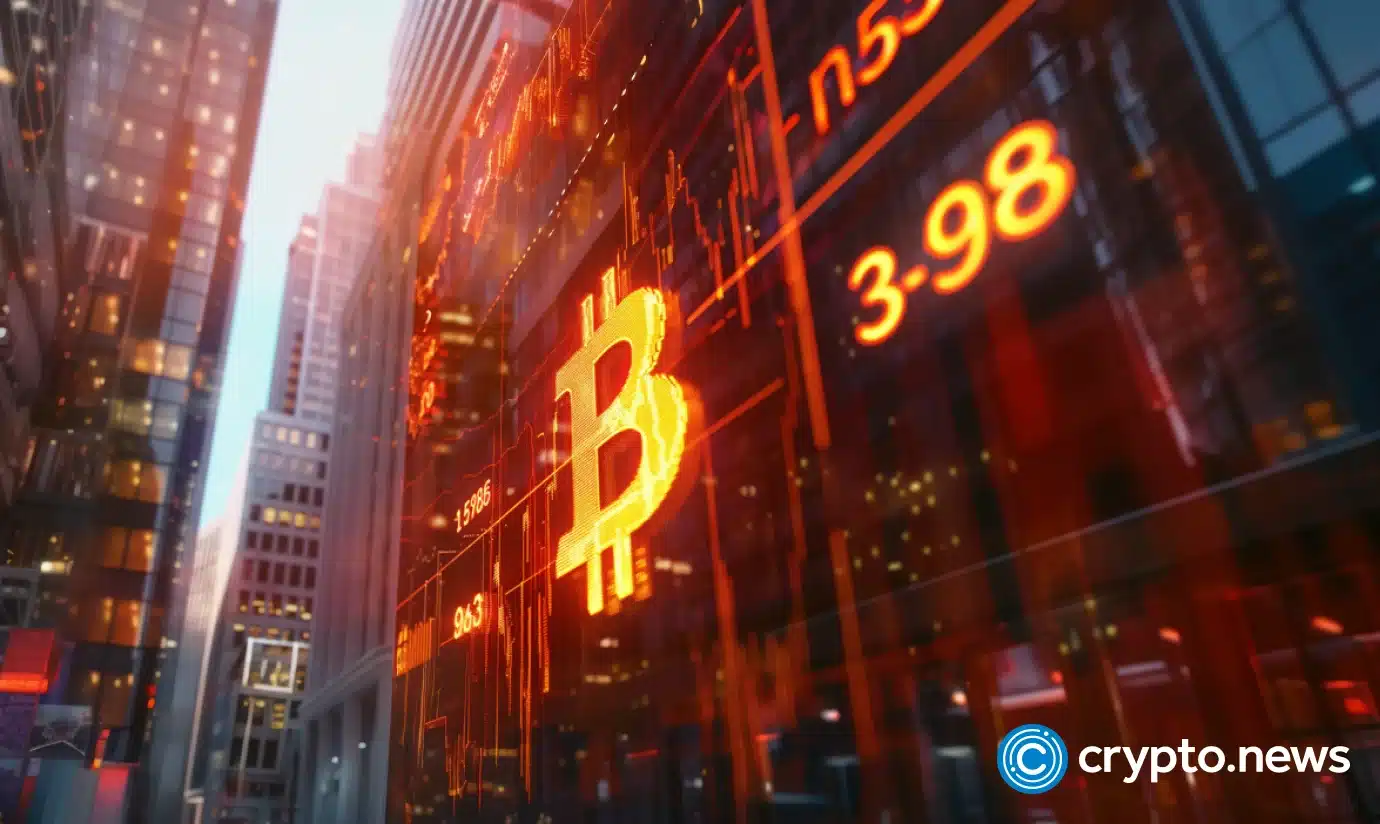
What are the immediate global triggers that have led to this massive crypto market crash? Read on
The crypto market has crashed brutally, sending shockwaves through the financial world. As of August 5, the global crypto market cap stands at $1.81 trillion, a staggering 15.88% decrease in just one day, triggering extreme panic and strong indications of a bear market.
Bitcoin (BTC) has plummeted over 25% in the last seven days, with nearly 15% of that decline occurring in the last 24 hours, trading at $51,300 levels as of August 5.

Ethereum (ETH) has fared even worse, falling by 32% in the last week and over 21% in the past day, trading at $2,238 levels as of this writing.
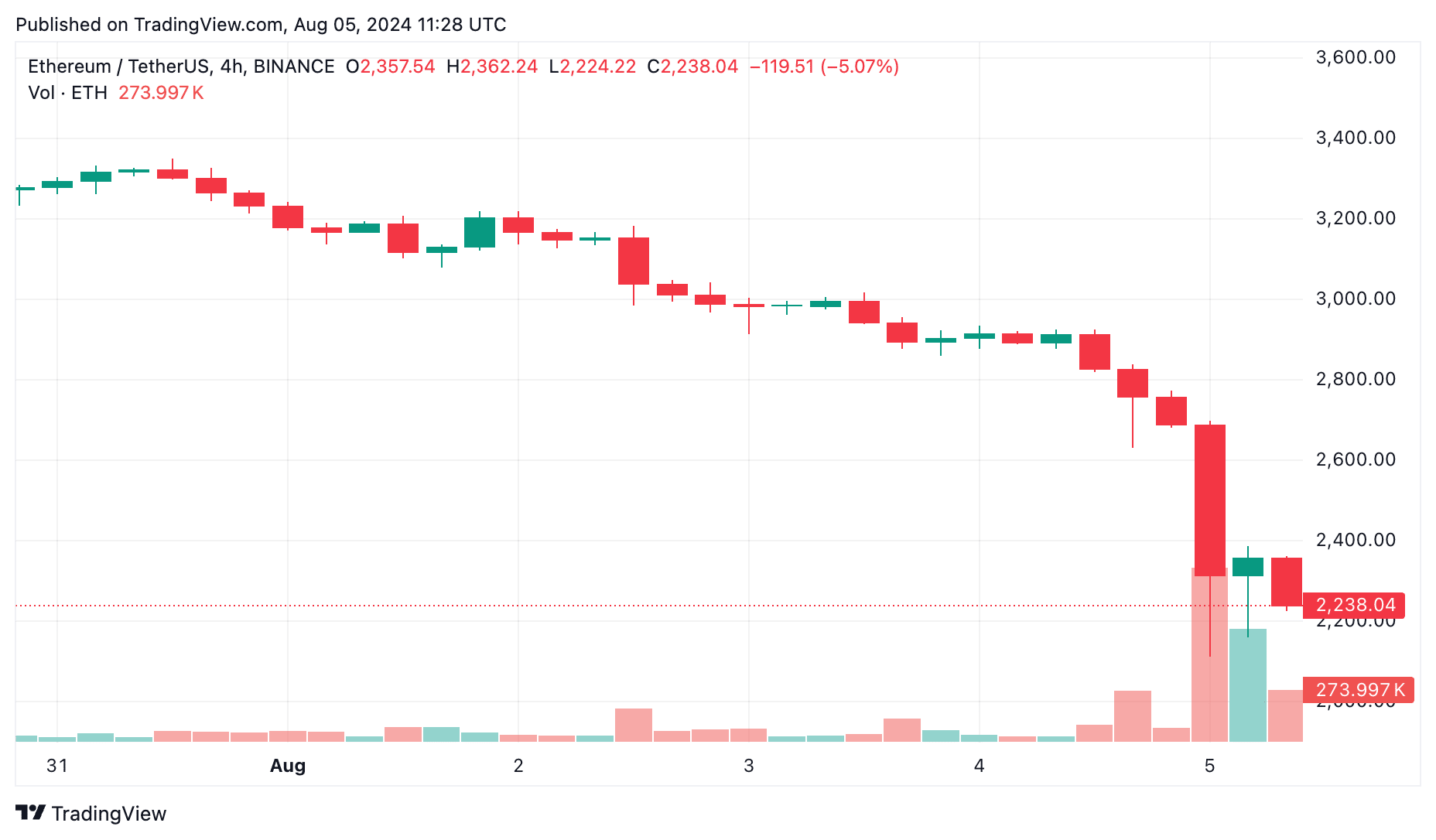
Other altcoins have been hit hard, too, dropping between 40-50% over the week and 15-25% in the last 24 hours.
The turbulence isn’t limited to the crypto market. Major global stock indices like NASDAQ100 (U.S.), FTSE100 (UK), and NIFTY50 (India) have seen sharp declines of 2-3% in a single trading session.
Japan’s Nikkei225 took the worst hit, plunging nearly 14% in one day, marking its steepest decline since 1987.
So, why is crypto crashing right now? What are the global triggers causing this widespread panic and dragging down all financial markets? Let’s delve into the underlying reasons behind this market turmoil.
What happened to crypto market: decoding the factors
U.S recession fears
The crypto market’s recent crash isn’t happening in isolation. The U.S. job market is showing signs of trouble, which is fueling fears of a recession.
According to data released on August 2, the unemployment rate jumped to a nearly three-year high of 4.3 percent in July, up from 4.1 percent in June and a stark increase from a five-decade low of 3.4 percent in April last year.
Economists from Goldman Sachs have increased the probability of a recession in the U.S. next year to 25 percent from 15 percent, Bloomberg reported.
Despite this, they noted there are “several reasons not to fear a slump,” even with the jump in unemployment. According to Goldman economists, ‘The economy continues to look fine overall, there are no major financial imbalances and the Fed has a lot of room to cut interest rates and can do so quickly if needed.’
However, there are also concerns that the Federal Reserve may have “waited too long” to cut interest rates. The Goldman report suggests that if job growth recovers in August, a 25 basis points (bps) cut would be sufficient to address any downside risks. But if the August employment report is as weak as July’s, a 50 bps cut might be necessary in September.
The rising unemployment and potential recession fears are creating a ripple effect. Investors are becoming more risk-averse, moving away from volatile assets like crypto, leading to massive sell-offs in the crypto space.
When people fear a recession, they tend to sell off riskier investments and hold onto safer assets like cash, gold, or government bonds.
Nikkei 225 crash
Japan’s financial system is undergoing some critical changes, and these shifts are having a ripple effect on markets worldwide.
On July 31, Japan’s central bank raised its benchmark interest rate to “around 0.25%” from its previous range of 0% to 0.1%. This was the second time this year that the Bank of Japan (BoJ) increased rates, the first being on March 19, marking the first rate hike since 2007.
While this move is aimed at benefiting Japan’s economy, it has an adverse impact on carry trade, a popular strategy among forex traders and fund managers.
Carry trade involves borrowing money in a currency with a low-interest rate and investing it in assets that offer higher returns. When Japan raises its interest rates, it makes the yen more attractive for borrowing, disrupting this strategy and causing global financial adjustments.
The effect of Japan’s rate hike was immediately felt. The Nikkei 225 stock index plunged 12.4% on August 5, marking a widespread sell-off.
One of the factors driving the BoJ to raise rates was the prolonged weakness in the Japanese yen, which has pushed inflation above the central bank’s 2% target.
Early on August 5, the dollar was trading at 142.59 yen, down from 146.45 late Friday and sharply below its level of over 160 yen a few weeks ago.
The market sell-off in Japan is not occurring in isolation. Stocks began tumbling globally on August 2 after weaker-than-expected data on U.S. jobs sparked worries that high interest rates might push the U.S. economy into a recession.
This anxiety is compounded by Japan’s rate hike, which adds another layer of complexity to the global financial picture.
The current scenario, where both U.S. and Japanese markets are showing signs of stress, is causing investors to reassess their positions. As a result, there is a massive sell-off in riskier assets, including cryptocurrencies.
Geopolitical woes
Geopolitical tensions are another major factor impacting the crypto market. On August 3, tensions in the Middle East escalated as Iran and its allies prepared their response to the assassination of Hamas leader Ismail Haniyeh in Tehran, an act they blamed on Israel.
This followed the killing of Hezbollah’s military chief in Beirut, prompting vows of vengeance from Iran and the ‘axis of resistance’, which raised fears of a regional war.
Meanwhile, the U.S., an ally of Israel, announced it would move warships and fighter jets to the region. Western governments urged their citizens to leave Lebanon, where the powerful Iran-backed Hezbollah movement is based, and airlines canceled flights.
Iran-backed groups from Lebanon, Yemen, Iraq, and Syria have already been drawn into the ongoing conflict between Israel and the Palestinian militant group Hamas in Gaza.
The fear of a regional war and its potential global implications can lead to massive sell-offs in the crypto market as investors seek stability. Geopolitical instability often causes heightened volatility in both traditional and crypto markets.
What’s next?
As the crypto market continues to tumble, let’s explore the insights of some prominent figures in the industry and analyze their perspectives on the situation.
Alex Krüger, a well-known macroeconomist, suggests that the current debacle is driven more by macroeconomic factors rather than issues specific to crypto.
Krüger argues that the policy mistake wasn’t the Fed not cutting rates quickly enough, but rather the Fed not cutting rates while Japan hiked theirs, creating a financial crisis spurred by levered Japanese speculators, which, according to him, is a less severe scenario than a crisis caused by a U.S. recession.
This debacle is obviously macro driven, rather than crypto specific. And it is becoming apparent the main driver is not the US economy collapsing (recession talks spiked post payrolls last Friday).
It seems the policy mistake was not the Fed not cutting fast enough, but rather… pic.twitter.com/PjTU7v2ZUY
— Alex Krüger (@krugermacro) August 5, 2024
Meanwhile, Justin Sun, the founder of Tron (TRX), remains optimistic despite the market downturn. He suggests that the industry has grown over the past year and that the current market fluctuations aren’t due to negative news.
Don’t worry! The industry has grown significantly over the past year, and this market fluctuation isn’t due to negative news. We should reject FUD and keep building. That’s why we’re creating a $1 billion fund to combat FUD, invest more, and provide liquidity. 🙏
— H.E. Justin Sun 孙宇晨 (@justinsuntron) August 5, 2024
In these turbulent times, you should exercise caution and stay informed. Diversify your portfolio to mitigate risks and avoid putting all your eggs in one basket.
Consider setting stop-loss orders to protect your investments from further decline. Don’t make impulsive decisions based on fear or market hype, and never invest more than you can afford to lose.
Source link
You may like


Experts say these 3 altcoins will rally 3,000% soon, and XRP isn’t one of them
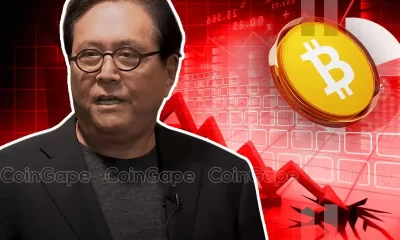

Robert Kiyosaki Hints At Economic Depression Ahead, What It Means For BTC?


BNB Steadies Above Support: Will Bullish Momentum Return?


Metaplanet makes largest Bitcoin bet, acquires nearly 620 BTC


Tron’s Justin Sun Offloads 50% ETH Holdings, Ethereum Price Crash Imminent?


Investors bet on this $0.0013 token destined to leave Cardano and Shiba Inu behind
24/7 Cryptocurrency News
Robert Kiyosaki Hints At Economic Depression Ahead, What It Means For BTC?
Published
2 hours agoon
December 23, 2024By
admin
Rich Dad Poor Dad author Robert Kiyosaki has issued a stark warning while hinting towards an economic depression ahead. In a recent X post, the renowned author said that the global market crash has already started, as he predicted earlier, which indicates that the financial market might enter a “depression” phase. Notably, this comes as the crypto market records immense volatility, sparking concerns over what’s next for Bitcoin (BTC).
Robert Kiyosaki Hints At Economic Depression Ahead
Robert Kiyosaki, in a recent X post, has revealed a stark warning of a looming economic depression. The Rich Dad Poor Dad author warned that a global market crash has already begun, citing Europe, China, and the U.S. as regions facing significant downturns.
In his post, Kiyosaki urged caution, advising individuals to safeguard their finances and maintain their jobs. “Global crash has started. Europe, China, USA going down. Depression ahead?” he asked while emphasizing the enduring value of assets like gold, silver, and Bitcoin. He added, “For many people, crashes are the best times to get rich.”
This warning aligns with Kiyosaki’s earlier prediction of what he called the “biggest crash in history.” Earlier this month, he encouraged his followers to prepare for financial turmoil, stating, “Please be proactive and get rich… before the BOOMER’s go BUST.”
However, this recent comment from Robert Kiyosaki indicates his sustained confidence in BTC. As the crypto market faces heightened volatility, Bitcoin could emerge as a hedge against traditional market instability, he noted. Besides, it also indicates that the flagship crypto, alongside gold and silver, might continue to gain traction amid this economic turmoil.
What’s Next For BTC?
Bitcoin price today has continued its volatile trading, losing nearly 1.5% over the last 24 hours to $95,323. The crypto touched a high and low of $97,260 and $93,690 in the last 24 hours, showcasing the highly volatile scenario in the market.
In addition, the US Spot Bitcoin ETF also recorded significant outflow, with BlackRock Bitcoin ETF witnessing its largest outflux since its launch. This has weighed on the investors’ sentiment, sparking concerns over a waning institutional interest.
However, despite that, many experts remained confident on the asset’s future trajectory. For context, in a recent X post, Peter Brandt shared a new BTC price target, indicating his confidence in the digital asset.
On the other hand, institutions like Metaplanet have also continued to boost their BTC holdings. These moves indicates that the institutions, as well as many investors, are bullish towards the long-term potential of the crypto. Besides, as Robert Kiyosaki said, the recent dip also provides a buying opportunity to investors, which might further boost Bitcoin to its new ATH ahead.
Rupam Roy
Rupam is a seasoned professional with three years of experience in the financial market, where he has developed a reputation as a meticulous research analyst and insightful journalist. He thrives on exploring the dynamic nuances of the financial landscape. Currently serving as a sub-editor at Coingape, Rupam’s expertise extends beyond conventional boundaries. His role involves breaking stories, analyzing AI-related developments, providing real-time updates on the crypto market, and presenting insightful economic news.
Rupam’s career is characterized by a deep passion for unraveling the complexities of finance and delivering impactful stories that resonate with a diverse audience.
Disclaimer: The presented content may include the personal opinion of the author and is subject to market condition. Do your market research before investing in cryptocurrencies. The author or the publication does not hold any responsibility for your personal financial loss.
Source link
Bitcoin
Metaplanet makes largest Bitcoin bet, acquires nearly 620 BTC
Published
4 hours agoon
December 23, 2024By
admin

Tokyo-listed Metaplanet has purchased another 9.5 billion yen ($60.6 million) worth of Bitcoin, pushing its holdings to 1,761.98 BTC.
Metaplanet, a publicly traded Japanese company, has acquired 619.7 Bitcoin as part of its crypto treasury strategy, paying an average of 15,330,073 yen per (BTC), with a total investment of 9.5 billion yen.
According to the company’s latest financial disclosure, Metaplanet’s total Bitcoin holdings now stand at 1,761.98 BTC, with an average purchase price of 11,846,002 yen (~$75,628) per Bitcoin. The company has spent 20.872 billion yen in total on Bitcoin acquisitions, the document reads.
The latest purchase is the largest so far for the Tokyo-headquartered company and comes just days after Metaplanet issued its 5th Series of Ordinary Bonds via private placement with EVO FUND, raising 5 billion yen (approximately $32 million).
The proceeds from this issuance, as disclosed earlier, were allocated specifically for purchasing Bitcoin. These bonds, set to mature in June 2025, carry no interest and allow for early redemption under specific conditions.
Metaplanet buys dip
The company also shared updates on its BTC Yield, a metric used to measure the growth of Bitcoin holdings relative to fully diluted shares. From Oct. 1 to Dec. 23, Metaplanet’s BTC Yield surged to 309.82%, up from 41.7% in the previous quarter.
Bitcoin itself has seen strong performance this year, climbing 120% and outperforming assets like the Nasdaq 100 and S&P 500 indices. However, it has recently pulled back from its all-time high of $108,427, trading at $97,000 after the Federal Reserve indicated only two interest rate cuts in 2025.
Despite the retreat, on-chain metrics indicate that Bitcoin is still undervalued based on its Market Value to Realized Value (MVRV-Z) score, which stands at 2.84 — below the threshold of 3.7 that historically signals an asset is overvalued.
Source link
Altcoin Season
End of Altcoin Season? Glassnode Co-Founders Warn Alts in Danger of Lagging Behind After Last Week’s Correction
Published
8 hours agoon
December 23, 2024By
admin
The creators of the crypto analytics firm Glassnode are warning that altcoins could lose all bullish momentum following last week’s market correction.
Jan Happel and Yann Allemann, who go by the handle Negentropic on the social media platform X, tell their 63,400 followers that “altcoin season,” which they say began in late November, could come to an abrupt end after alts witnessed deep pullbacks over the last seven days.
According to the Glassnode co-founders, traders and investors will likely have a risk-off approach on altcoins unless Bitcoin recovers a key psychological price point.
“Is This the End of Altcoin Season?
Bitcoin dominance is surging after dipping below $100,000, while altcoins are losing critical supports. Dominance has risen and resumed its upward trend, signaling a stronger BTC environment.
If BTC stabilizes above $100,00, we might see a pump in altcoins now in accumulation zones. Until then, Bitcoin appears poised to lead, leaving altcoins lagging behind.”
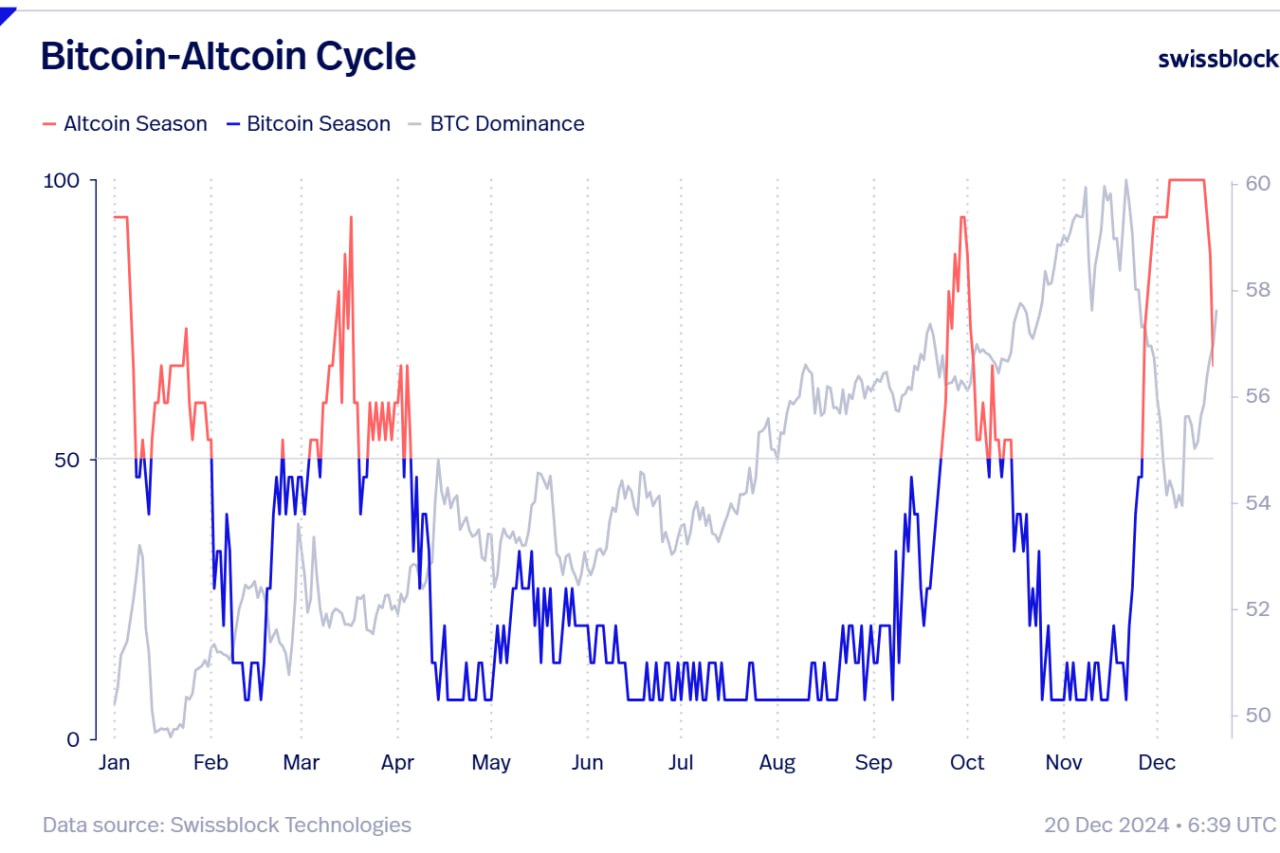
The Bitcoin Dominance (BTC.D) chart tracks how much of the total crypto market cap belongs to BTC. In the current state of the market, a surging BTC.D suggests that altcoins are losing value faster than Bitcoin.
At time of writing, BTC.D is hovering at 59%.
Looking at Bitcoin itself, the Glassnode executives say long-term Bitcoin holders are massively unloading their holdings as other investor cohorts pick up the slack.
“The Board Keeps Shifting.
As BTC continues flowing out of exchanges during this dip, long-term holders are exiting forcefully, while short-term holders step in without hesitation.
Whales quietly accumulate, miners remain neutral, and selling pressure has merely reshuffled the board.
New hands are absorbing the sales.”
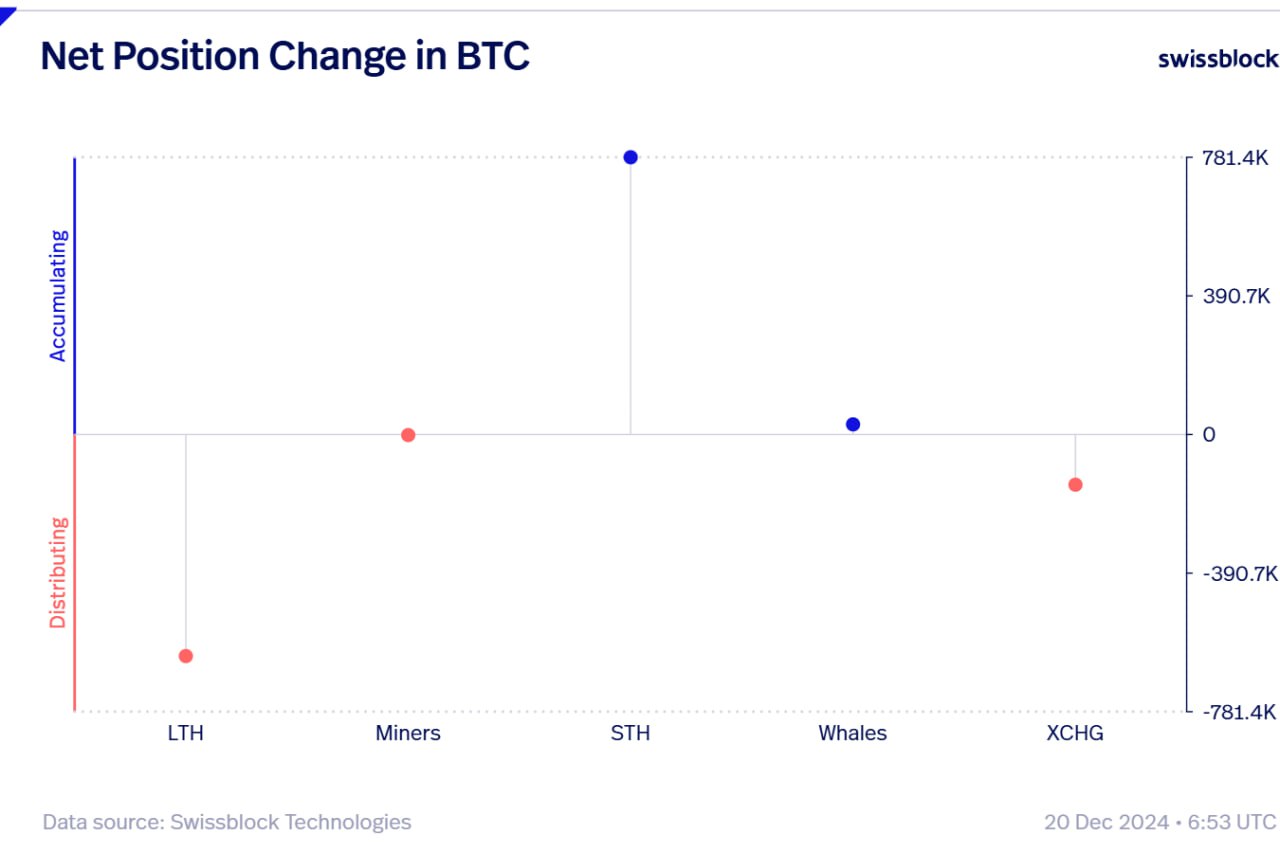
At time of writing, Bitcoin is worth $97,246.
Don’t Miss a Beat – Subscribe to get email alerts delivered directly to your inbox
Check Price Action
Follow us on X, Facebook and Telegram
Surf The Daily Hodl Mix
 

Disclaimer: Opinions expressed at The Daily Hodl are not investment advice. Investors should do their due diligence before making any high-risk investments in Bitcoin, cryptocurrency or digital assets. Please be advised that your transfers and trades are at your own risk, and any losses you may incur are your responsibility. The Daily Hodl does not recommend the buying or selling of any cryptocurrencies or digital assets, nor is The Daily Hodl an investment advisor. Please note that The Daily Hodl participates in affiliate marketing.
Generated Image: DALLE3
Source link

Experts say these 3 altcoins will rally 3,000% soon, and XRP isn’t one of them

Robert Kiyosaki Hints At Economic Depression Ahead, What It Means For BTC?

BNB Steadies Above Support: Will Bullish Momentum Return?

Metaplanet makes largest Bitcoin bet, acquires nearly 620 BTC

Tron’s Justin Sun Offloads 50% ETH Holdings, Ethereum Price Crash Imminent?

Investors bet on this $0.0013 token destined to leave Cardano and Shiba Inu behind

End of Altcoin Season? Glassnode Co-Founders Warn Alts in Danger of Lagging Behind After Last Week’s Correction

Can Pi Network Price Triple Before 2024 Ends?

XRP’s $5, $10 goals are trending, but this altcoin with 7,400% potential takes the spotlight

CryptoQuant Hails Binance Reserve Amid High Leverage Trading

Trump Picks Bo Hines to Lead Presidential Crypto Council

The introduction of Hydra could see Cardano surpass Ethereum with 100,000 TPS

Top 4 Altcoins to Hold Before 2025 Alt Season

DeFi Protocol Usual’s Surge Catapults Hashnote’s Tokenized Treasury Over BlackRock’s BUIDL

DOGE & SHIB holders embrace Lightchain AI for its growth and unique sports-crypto vision
182267361726451435

Why Did Trump Change His Mind on Bitcoin?

Top Crypto News Headlines of The Week

New U.S. president must bring clarity to crypto regulation, analyst says

Will XRP Price Defend $0.5 Support If SEC Decides to Appeal?

Bitcoin Open-Source Development Takes The Stage In Nashville

Ethereum, Solana touch key levels as Bitcoin spikes

Bitcoin 20% Surge In 3 Weeks Teases Record-Breaking Potential

Ethereum Crash A Buying Opportunity? This Whale Thinks So

Shiba Inu Price Slips 4% as 3500% Burn Rate Surge Fails to Halt Correction

Washington financial watchdog warns of scam involving fake crypto ‘professors’

‘Hamster Kombat’ Airdrop Delayed as Pre-Market Trading for Telegram Game Expands

Citigroup Executive Steps Down To Explore Crypto
Mostbet Güvenilir Mi – Casino Bonus 2024

NoOnes Bitcoin Philosophy: Everyone Eats
Trending

 3 months ago
3 months ago182267361726451435

 Donald Trump5 months ago
Donald Trump5 months agoWhy Did Trump Change His Mind on Bitcoin?

 24/7 Cryptocurrency News4 months ago
24/7 Cryptocurrency News4 months agoTop Crypto News Headlines of The Week

 News4 months ago
News4 months agoNew U.S. president must bring clarity to crypto regulation, analyst says

 Price analysis4 months ago
Price analysis4 months agoWill XRP Price Defend $0.5 Support If SEC Decides to Appeal?

 Opinion5 months ago
Opinion5 months agoBitcoin Open-Source Development Takes The Stage In Nashville

 Bitcoin5 months ago
Bitcoin5 months agoEthereum, Solana touch key levels as Bitcoin spikes

 Bitcoin5 months ago
Bitcoin5 months agoBitcoin 20% Surge In 3 Weeks Teases Record-Breaking Potential



✓ Share: